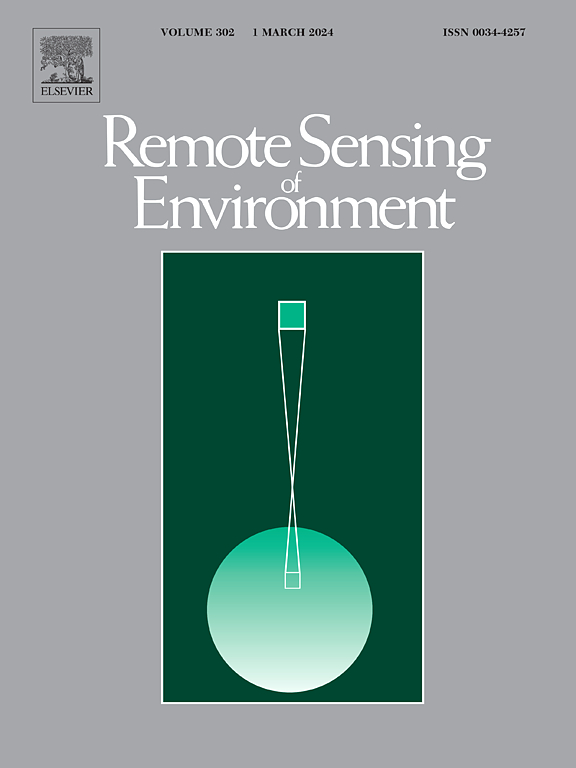基于地理空间基础模型的自监督学习估算基于卫星SAR和光学观测的作物生物物理参数
IF 11.1
1区 地球科学
Q1 ENVIRONMENTAL SCIENCES
引用次数: 0
摘要
植被含水量(VWC)和作物高度的准确知识对于农业管理、环境监测和基于卫星的地球物理变量检索算法至关重要。传统的VWC估算方法主要依靠光学指标,存在生物量饱和度和对大气条件敏感性的局限性。本研究介绍了地理空间基础模型(GFMs)的一种新应用,通过自监督学习利用广泛的未标记数据集来提高VWC和作物高度估计的技能。基于Sentinel-1 a c波段SAR和Sentinel-2 a /B指数与天气参数的综合模型,对大豆和玉米的VWC和作物高度进行了估算。我们的研究区域跨越了各种气候带和管理实践,从爱荷华州和密歇根州的湿润大陆性气候到佛罗里达州的亚热带环境,包括灌溉和非灌溉领域以及各种耕作实践。我们比较了单任务学习GFM (STL-GFM)、多任务学习GFM (MTL-GFM)以及包括随机森林(RF)和XGBoost (XGB)在内的机器学习技术的性能,以评估它们在估计VWC和作物高度方面的有效性。结果表明,STL-GFM在准确性和泛化性方面优于其他方法。对于VWC估计,STL-GFM对大豆和玉米的R2分别为0.90和0.89。对于作物高度,大豆和玉米的R2分别为0.95和0.98。综合SAR、光学和气候数据提供了比使用单个数据源更可靠的估算。特征重要性分析表明,NDVI、NDWI、VH后向散射和降水是准确估算VWC和高度的关键驱动因素。红边带对VWC估计有重要意义,但对高度预测的重要性有限。值得注意的是,表面粗糙度对玉米VWC和高度估计的影响显著,而土壤湿度的影响比最初预期的要小。值得注意的是,在没有直接纳入土壤湿度和表面粗糙度数据的情况下,通过在训练和验证中纳入不同的野外条件,STL-GFM模型显示出强大的泛化能力。本研究强调了GFMs在推进作物监测技术、为精准农业提供更可靠的数据以及支持跨多种农业景观的可持续农业实践方面的潜力。本文章由计算机程序翻译,如有差异,请以英文原文为准。
Estimating crop biophysical parameters from satellite-based SAR and optical observations using self-supervised learning with geospatial foundation models
Accurate knowledge of vegetation water content (VWC) and crop height is crucial for agricultural management, environmental monitoring, and for satellite-based retrieval algorithms for geophysical variables. Traditional methods to estimate VWC, primarily rely on optical indices, which has limitations of biomass saturation, and sensitivity to atmospheric conditions. This study introduces a novel application of geospatial foundation models (GFMs), leveraging extensive, unlabeled datasets through self-supervised learning to enhance the skill of VWC and crop height estimation. We developed a comprehensive model integrating Sentinel-1 A C-band SAR and Sentinel-2 A/B indices with weather parameters to estimate soybean and corn VWC and crop height.
Our research study area spans a variety of climatic zones and management practices, from the humid continental climate of Iowa and Michigan to the subtropical environment of Florida, encompassing both irrigated and non-irrigated fields as well as diverse tillage practices. We compared the performance of Single-Task Learning GFM (STL-GFM), Multi-Task Learning GFM (MTL-GFM), and machine learning techniques including Random Forest (RF), and XGBoost (XGB) to evaluate their effectiveness in estimating VWC and crop height.
Results demonstrated that STL-GFM outperforms other methods in accuracy and generalizability. For VWC estimation, STL-GFM achieved R2 values of 0.90 and 0.89 for soybean and corn, respectively. For crop height, R2 values reached 0.95 for soybean and 0.98 for corn. The integration of SAR, optical, and climate data provided more reliable estimations than using individual data sources.
Feature importance analysis identified NDVI, NDWI, VH backscatter, and precipitation as key drivers for accurate VWC and height estimations. The red-edge band emerged as significant for VWC estimation but showed limited importance for height prediction. Notably, surface roughness demonstrated a noticeable impact on corn VWC and height estimations, while soil moisture exhibited less influence than initially anticipated. Notably, without directly incorporating soil moisture and surface roughness data, but by including diverse field conditions in training and validation, the STL-GFM model demonstrated strong generalization capabilities. This study highlights the potential of GFMs in advancing crop monitoring techniques, offering more reliable data for precision agriculture, and supporting sustainable farming practices across diverse agricultural landscapes.
求助全文
通过发布文献求助,成功后即可免费获取论文全文。
去求助
来源期刊

Remote Sensing of Environment
环境科学-成像科学与照相技术
CiteScore
25.10
自引率
8.90%
发文量
455
审稿时长
53 days
期刊介绍:
Remote Sensing of Environment (RSE) serves the Earth observation community by disseminating results on the theory, science, applications, and technology that contribute to advancing the field of remote sensing. With a thoroughly interdisciplinary approach, RSE encompasses terrestrial, oceanic, and atmospheric sensing.
The journal emphasizes biophysical and quantitative approaches to remote sensing at local to global scales, covering a diverse range of applications and techniques.
RSE serves as a vital platform for the exchange of knowledge and advancements in the dynamic field of remote sensing.
 求助内容:
求助内容: 应助结果提醒方式:
应助结果提醒方式:


